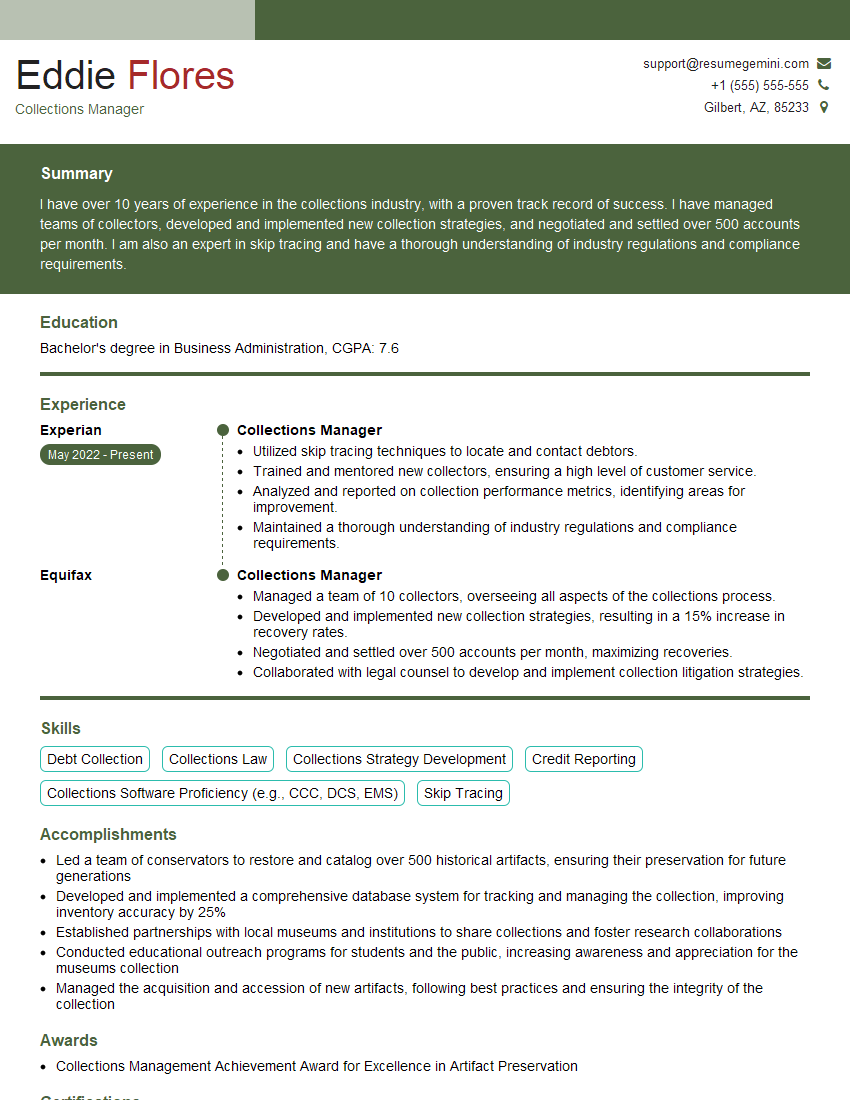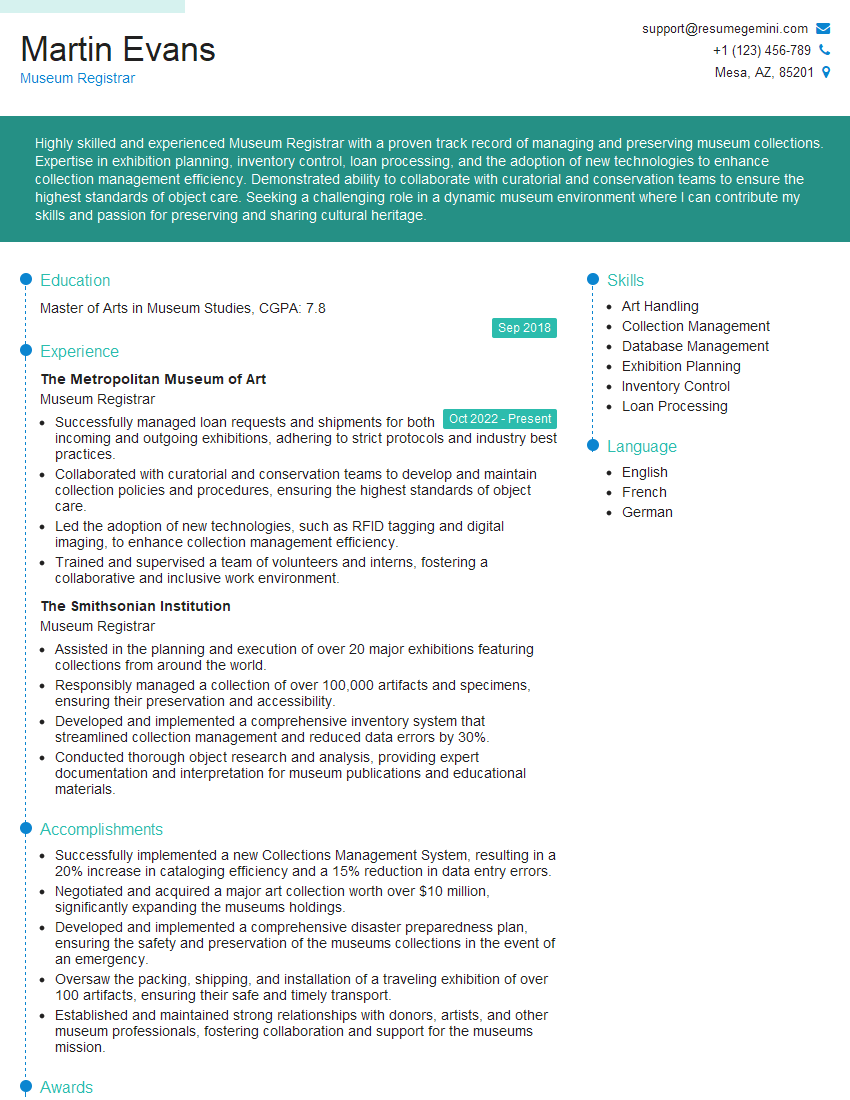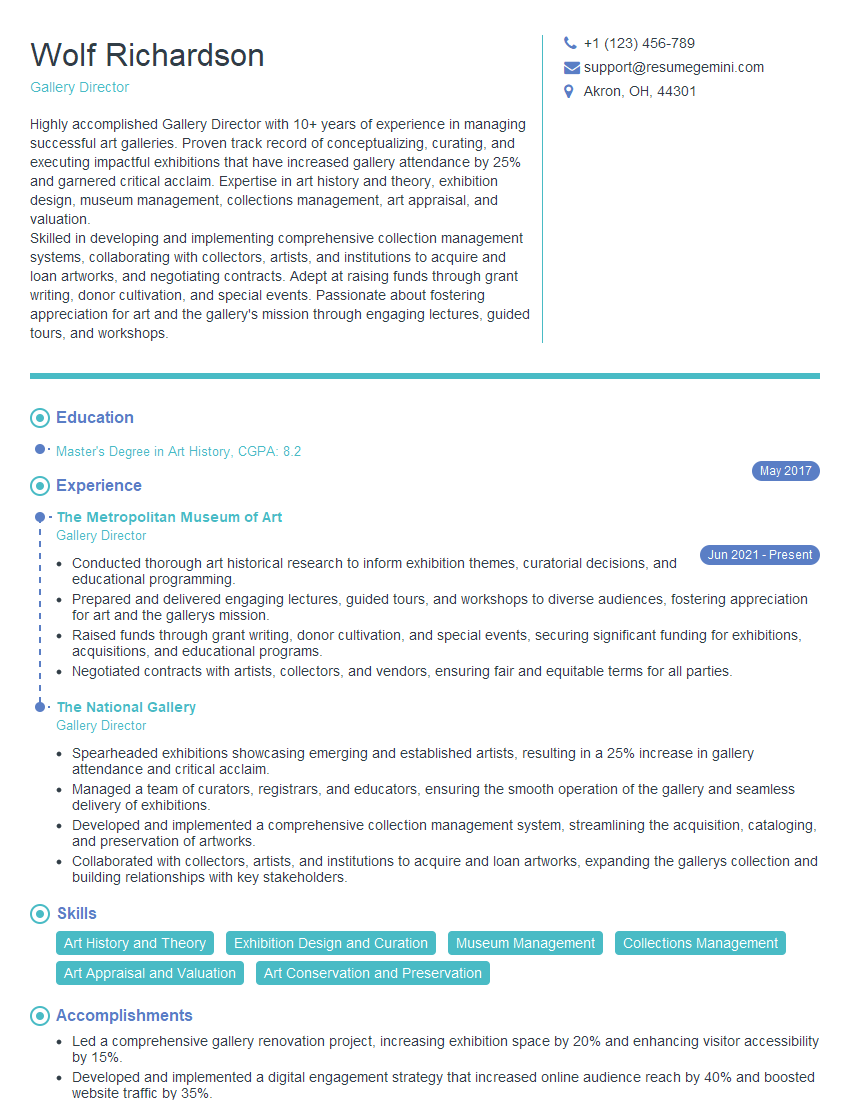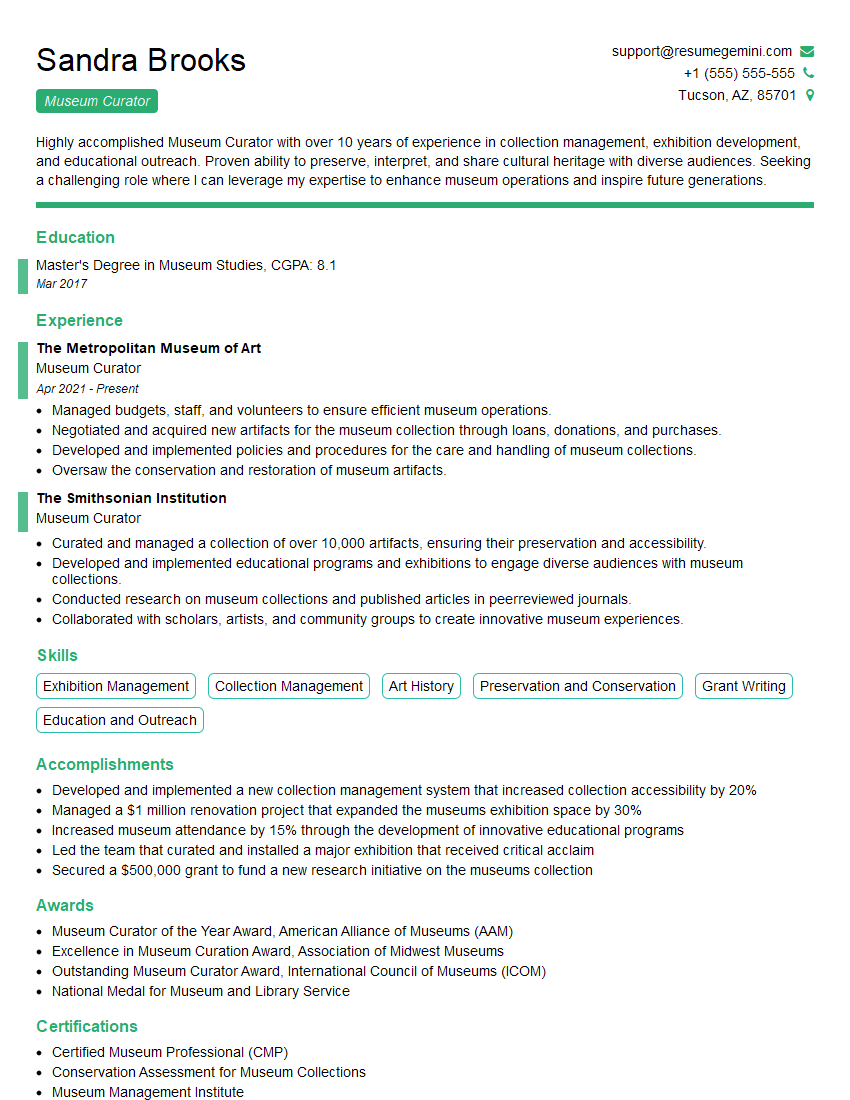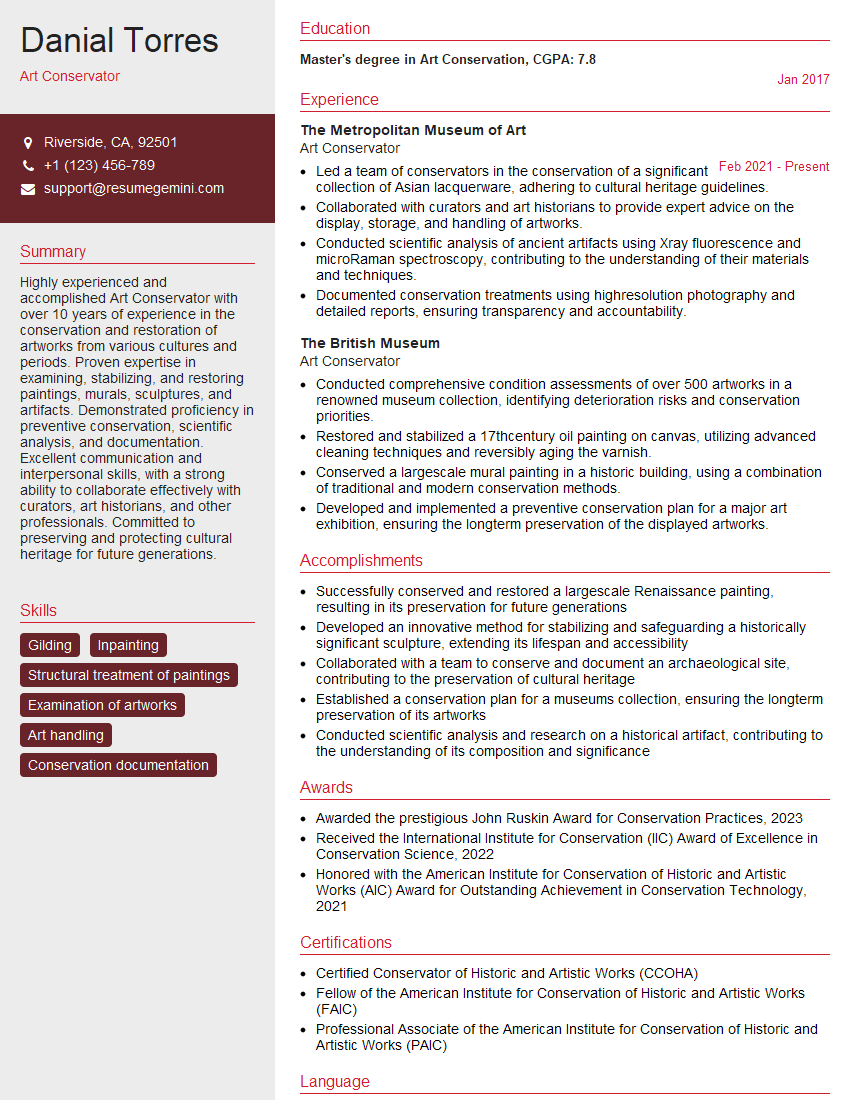Interviews are opportunities to demonstrate your expertise, and this guide is here to help you shine. Explore the essential Ability to handle delicate and valuable artwork interview questions that employers frequently ask, paired with strategies for crafting responses that set you apart from the competition.
Questions Asked in Ability to handle delicate and valuable artwork Interview
Q 1. Describe your experience handling fragile artwork, including specific materials and techniques.
Handling fragile artwork requires a meticulous approach, combining knowledge of materials with careful technique. My experience spans working with diverse materials, including delicate porcelain sculptures, intricate oil paintings on canvas, and ancient artifacts made from stone and wood. For porcelain, I utilize acid-free tissue paper and custom-fit foam inserts within sturdy crates to prevent shifting and impact. With canvases, I prioritize controlled movement to avoid stretching or tearing, using cotton gloves and supporting the stretcher bars at all times. Stone and wood artifacts often require specialized cradles and supports within the crate to minimize vibration and pressure points during transport. I always adapt my approach to the specific material’s vulnerabilities. For instance, gilded frames require extra padding to prevent abrasion, and works on paper need to be kept flat to avoid creasing.
Consider this example: I once handled a 17th-century porcelain vase. To prepare it for transport, I first carefully wrapped it in acid-free tissue paper, then placed it in a custom-made foam cradle that perfectly mirrored the vase’s shape. This cradle was then placed inside a wooden crate with additional cushioning. This multi-layered approach ensured that the vase remained protected from shock and vibration.
Q 2. Explain the process of packing and crating a large, delicate sculpture for transport.
Packing and crating a large, delicate sculpture for transport is a multi-stage process demanding precision and planning. First, I conduct a thorough assessment of the sculpture’s dimensions, weight, and fragility, identifying any vulnerable points. Next, I select appropriate materials: custom-fit foam inserts, acid-free cushioning materials (like bubble wrap or polyethylene foam), and a sturdy wooden crate designed to withstand significant stress. The sculpture is carefully wrapped, layer by layer, to minimize movement and protect vulnerable areas. Fragile sections may require individual support systems within the crate. I ensure the crate’s interior is properly cushioned, preventing any direct contact between the sculpture and the crate itself. Finally, the crate is securely sealed and labeled with appropriate handling instructions—including ‘fragile,’ ‘this way up,’ and contact information.
For example, when transporting a large bronze sculpture, I would create a custom-fit cradle from high-density foam, ensuring it perfectly supports the sculpture’s weight and shape. This cradle would then be secured within a robust wooden crate with additional shock-absorbing materials filling any remaining space. The crate itself would be designed to be easily handled with appropriate lifting points.
Q 3. What are the different types of environmental hazards that can damage artwork, and how can they be mitigated?
Environmental hazards pose significant threats to artwork. These include:
- Temperature fluctuations: Extreme heat or cold can cause warping, cracking, or fading.
- Humidity: High humidity can encourage mold and mildew growth, while low humidity can cause materials to become brittle.
- Light exposure: UV radiation from sunlight can cause fading and discoloration.
- Pests: Insects and rodents can damage artwork through chewing, nesting, or contaminating it with waste.
- Air pollutants: Airborne pollutants can cause discoloration and deterioration.
Mitigation involves environmental control. This includes maintaining stable temperatures and humidity levels using climate-controlled storage and transport environments. UV-filtering materials are used to protect from sunlight. Regular pest control measures are essential, and air filtration can minimize the impact of pollutants. Proper storage environments—free from dust and pollutants—are crucial for long-term preservation.
Q 4. How do you identify potential damage to artwork during inspection?
Identifying potential damage requires a keen eye and systematic approach. I begin with a visual inspection, noting any cracks, scratches, discoloration, or loose components. I use a magnifying glass to examine delicate areas for subtle damage. For paintings, I check for flaking paint, canvas tears, and signs of previous repairs. For sculptures, I look for stress fractures, loose attachments, or surface damage. I document all findings with detailed photographs and written notes, comparing the piece to any available documentation or previous condition reports.
For instance, I might notice a small crack in a porcelain figurine only visible under magnification. Proper documentation is key, ensuring that any pre-existing damage is noted, differentiating it from potential new damage that could occur during handling.
Q 5. What are your strategies for lifting and moving heavy or awkwardly shaped artwork safely?
Lifting and moving heavy or awkwardly shaped artwork demands a safe and planned approach. I never attempt to lift anything beyond my physical capabilities. For heavy pieces, I use appropriate lifting equipment—such as dollies, hand trucks, or specialized lifting systems—and enlist the help of colleagues to ensure a coordinated and controlled lift. For awkwardly shaped pieces, I devise a customized strategy, using straps, padding, and supports to distribute the weight evenly and maintain stability during movement. Smooth, controlled movements are essential to prevent jarring or sudden shifts. The chosen path is carefully considered to avoid obstacles and ensure a clear route.
For example, moving a large, heavy stone sculpture might involve using a specialized art handling dolly with a wide base for stability, reinforced straps to secure the sculpture, and multiple handlers to ensure a safe and controlled move. The floor should be inspected for uneven surfaces or obstacles before the move.
Q 6. What safety precautions do you take when handling artwork?
Safety is paramount. I always wear appropriate personal protective equipment (PPE), including cotton gloves to prevent oil transfer and smudging, safety glasses to protect my eyes from debris, and sturdy footwear for good footing. I maintain a clear work area, removing any obstacles that could cause tripping or falls. I ensure adequate lighting to minimize shadows and enhance visibility. Before any lifting, I assess the weight and stability of the object, and enlist help when needed. I follow all relevant safety regulations and always prioritize a controlled and safe working environment.
Using appropriate lifting techniques, like bending at the knees, is crucial to prevent back injuries when moving heavier pieces. Communication with colleagues during team lifts is essential to ensure coordinated and safe movement.
Q 7. Explain your experience with different types of artwork packaging materials and their applications.
My experience encompasses a variety of packaging materials, each suited to different artwork types. Acid-free tissue paper is essential for protecting delicate surfaces from abrasion. Foam sheeting and custom-cut foam inserts provide excellent cushioning and support for three-dimensional objects. Bubble wrap offers affordable and versatile cushioning, though less suitable for delicate items. Corrugated cardboard is a cost-effective option for outer packaging, but its strength needs to be evaluated carefully. For significant protection during transit, wooden crates are crucial, especially for large or fragile pieces. Crates can be custom designed to maximize protection and accommodate the specific shape and weight of the artwork.
For a painting on canvas, I might use acid-free tissue paper, followed by bubble wrap, and then place it inside a sturdy cardboard box filled with additional cushioning material. For a fragile sculpture, I would use a custom-made foam cradle within a robust wooden crate for the highest level of protection.
Q 8. How do you ensure the proper climate control and storage conditions for different types of artwork?
Maintaining the ideal environment for artwork is paramount to its preservation. Different materials react differently to temperature and humidity fluctuations. For example, oil paintings are vulnerable to cracking in dry conditions, while watercolors can be damaged by excessive moisture.
My approach involves using calibrated monitoring systems to maintain precise temperature and humidity levels within the recommended ranges for each piece. This often necessitates climate-controlled storage facilities, with separate areas for different media. For instance, I would store oil paintings in a slightly cooler and drier environment than watercolors, which require more stable humidity to prevent buckling or warping. I also consider light exposure – UV filtering glass and controlled lighting are crucial to prevent fading, especially for photographs and pastels. Regular monitoring and adjustments ensure the long-term health of the art.
- Oil Paintings: Temperature: 65-72°F (18-22°C); Humidity: 45-55%
- Watercolors: Temperature: 68-72°F (20-22°C); Humidity: 50-55%
- Photographs: Temperature: 65-72°F (18-22°C); Humidity: 30-40%, low light exposure
Q 9. Describe your experience with art installation, including wall mounting and display techniques.
Art installation requires a meticulous approach. My experience encompasses various techniques, from delicate tapestry mounting to robust sculpture installation. I’ve worked with numerous wall types, each requiring specific hanging methods. For instance, plaster walls need different considerations than drywall. I always assess the wall’s structural integrity before drilling and select appropriate hardware to ensure the artwork is securely and safely displayed.
Wall mounting involves choosing the correct hanging system based on the artwork’s weight and size. This includes using appropriate screws, anchors, and wire systems. For delicate pieces, I may use specialized museum-grade hanging systems that minimize pressure points. For larger pieces, we might utilize custom-fabricated frames or support structures. Display techniques also vary, depending on the type of artwork and the desired aesthetic. For instance, sculptures might be displayed on pedestals, or paintings could be positioned with anti-reflective glazing to enhance viewing.
For example, while installing a large tapestry, I employed a custom-designed tensioning system to evenly distribute the weight and prevent stretching or damage during the installation. Each step was meticulously documented, including photographic evidence before, during, and after the installation.
Q 10. What is your process for documenting the condition of artwork before, during, and after handling?
Condition documentation is crucial for insurance purposes and future reference. My process involves a systematic approach before, during, and after handling any piece of art.
Before handling: I conduct a thorough visual inspection, noting any existing damage, such as cracks, scratches, or discoloration. This includes close-up photography and detailed written descriptions, often including a condition report using standardized terminology. The location of any damage is meticulously recorded.
During handling: I take further photographic documentation throughout the handling process – transport, installation, and storage. Any issues encountered are documented immediately.
After handling: I perform a final inspection, comparing the artwork’s condition to the initial documentation. Any new damage or changes are documented with photographic evidence and detailed descriptions, outlining the cause if known. This detailed record provides a complete history of the artwork’s condition throughout its handling. This information is vital for insurance claims and provides valuable data for future preservation efforts.
Q 11. How do you handle artwork that has already sustained minor damage?
Handling artwork with pre-existing damage requires extra care and specialized techniques. The approach depends entirely on the nature and extent of the damage. For minor damage, such as small scratches or tears, conservation techniques may be employed depending on the material.
For instance, a minor tear in a canvas painting might be carefully repaired using specialized adhesive and conservation-grade materials. Scratches on a wooden frame can sometimes be subtly repaired with pigmented wax to match the original finish. However, any significant repair or restoration would require the expertise of a professional art conservator. My role would be to document the damage accurately before any intervention and to collaborate closely with the conservator to ensure the best possible outcome.
It’s crucial to avoid any actions that could worsen the existing damage. For example, I would avoid applying pressure to the damaged area, and I would use appropriate materials and handling techniques to minimize any further risk. Documentation is even more crucial in such cases, providing a clear record of the artwork’s condition before, during, and after any intervention.
Q 12. Explain your experience working with specialized equipment for handling large-scale artwork.
My experience includes using various specialized equipment for handling large-scale artworks. This includes art handling dollies, specialized straps, and lifting equipment like gantries and air-ride systems for oversized and fragile sculptures or installations.
I’m proficient in operating these systems safely and efficiently, ensuring the artwork’s security during transport and installation. This often involves working with teams of trained professionals to coordinate the movements of large or heavy objects. Safety procedures are paramount, always ensuring the artwork, personnel, and surrounding environment are protected. For example, we might utilize custom-designed crates and protective coverings to cushion the artwork during transport, and we would employ a detailed lifting plan to mitigate any risk of damage or injury during installation.
One project involved the careful transport and installation of a monumental bronze sculpture. Using a specialized air-ride system, which minimizes shock and vibration, ensured the safe arrival and placement of the piece. The entire process was meticulously planned and executed, with careful attention paid to every detail of the operation.
Q 13. How familiar are you with different types of art insurance and risk management procedures?
Familiarity with art insurance and risk management is essential for protecting valuable artwork. I understand various types of insurance policies, including fine art insurance, which covers damage, theft, and loss. I also know about transit insurance, which protects artworks while in transit. I’m aware of the necessity of comprehensive documentation – condition reports, photographic records, and valuation appraisals – which are crucial for insurance claims.
Risk management involves identifying potential hazards and implementing strategies to mitigate them. This includes security measures such as alarms, surveillance, and controlled access to storage and display areas. Environmental factors, such as temperature and humidity fluctuations, are also considered to develop preventative measures and minimize potential damage. Understanding and applying these principles ensure the artwork’s safety and minimize potential financial losses.
For instance, I would recommend a particular type of insurance based on the value and fragility of the artwork, and I would discuss appropriate security measures to protect it against theft or damage.
Q 14. How do you prioritize tasks when handling multiple pieces of artwork simultaneously?
Prioritizing tasks when handling multiple artworks involves a structured approach. I use a system that considers several factors: urgency, fragility, and the deadlines involved. This often involves creating a detailed schedule and assigning priorities based on a risk assessment.
For example, I might prioritize the most fragile artwork first, particularly if it requires special handling or environmental conditions. Works with impending deadlines, such as those going to an exhibition, take precedence. Using project management tools, including checklists and timelines, keeps me organized and on track. Clear communication with clients and team members is crucial to ensure everyone is informed of the plan and can contribute effectively. This methodical approach ensures all tasks are completed efficiently and safely, safeguarding the valuable artworks entrusted to my care.
Q 15. What is your experience with handling artwork from different historical periods and cultural backgrounds?
My experience spans a wide range of historical periods and cultural backgrounds. I’ve worked with ancient Egyptian artifacts, delicate Renaissance paintings, intricate Asian ceramics, and contemporary sculptures. Each piece presents unique challenges and requires a deep understanding of its materials, construction techniques, and inherent vulnerabilities. For example, handling a fragile Ming Dynasty vase demands a far different approach than moving a robust pre-Columbian stone carving. This understanding isn’t just about the physical properties; it encompasses the cultural significance. Knowing the history and value of an artwork informs every decision, from the type of gloves I wear to the environmental controls I request.
- Renaissance Paintings: Requires understanding the canvas, pigments, and potential for cracking or flaking, demanding careful handling and controlled environmental conditions.
- Ancient Egyptian Artifacts: Often fragile and made of materials susceptible to damage from light and humidity, requiring specialized handling and storage procedures.
- Contemporary Sculptures: Might involve a variety of materials and construction methods, needing assessment and handling techniques adjusted accordingly.
Career Expert Tips:
- Ace those interviews! Prepare effectively by reviewing the Top 50 Most Common Interview Questions on ResumeGemini.
- Navigate your job search with confidence! Explore a wide range of Career Tips on ResumeGemini. Learn about common challenges and recommendations to overcome them.
- Craft the perfect resume! Master the Art of Resume Writing with ResumeGemini’s guide. Showcase your unique qualifications and achievements effectively.
- Don’t miss out on holiday savings! Build your dream resume with ResumeGemini’s ATS optimized templates.
Q 16. How do you adapt your techniques when handling artwork in various settings (e.g., gallery, museum, private collection)?
Adaptability is paramount. Handling artwork in a museum requires adherence to strict protocols and often involves teamwork with other professionals like conservators and registrars. In a private collection, the focus shifts towards the owner’s preferences and the specific environmental conditions of their space. A gallery setting necessitates careful consideration of public access and potential risks of accidental damage. My techniques adapt to the context:
- Museum: Strict adherence to established handling procedures, utilizing specialized equipment, and meticulous documentation.
- Private Collection: More flexible approach, tailored to the owner’s needs and the unique characteristics of their space, prioritizing environmental monitoring and security.
- Gallery: Prioritizing display security, minimizing risk of accidental damage from the public, and rapid response to any potential incidents.
Q 17. Describe a time you encountered an unexpected challenge while handling artwork. How did you resolve it?
During a transport of a large, intricate bronze sculpture, the custom-built crate unexpectedly shifted during transit, causing a minor crack in the sculpture’s base. My immediate response was to halt the transport, secure the sculpture, and thoroughly document the damage with high-resolution photography and a detailed written report. I then contacted the conservator and the client, keeping them fully informed. The conservator advised on a temporary stabilization method to prevent further damage. The sculpture underwent restoration after the incident, and the timely response minimized the impact of the crack and prevented further deterioration.
Q 18. What are the key considerations for transporting artwork across international borders?
International transport necessitates meticulous planning and adherence to stringent regulations. Key considerations include:
- Customs regulations and documentation: Accurate and comprehensive paperwork, including certificates of authenticity, provenance documentation, and permits if required.
- Environmental controls: Maintaining stable temperature and humidity during transit to prevent damage. This often involves climate-controlled containers or specialized transport vehicles.
- Insurance and security: Securing appropriate insurance coverage for the artwork’s full value and employing secure transportation methods with tracking capabilities.
- Packaging and crating: Employing custom-designed crates and packaging materials to protect the artwork from shocks, vibrations, and environmental factors during transit.
- Compliance with international laws: Understanding and complying with all relevant international import/export regulations of both countries.
Q 19. What are the ethical considerations in handling valuable artwork?
Ethical considerations are paramount. The handling of valuable artwork demands the highest levels of integrity and professionalism. This includes:
- Transparency and honesty: Maintaining open communication with clients and stakeholders, fully disclosing any potential risks or challenges.
- Confidentiality: Protecting the privacy and security of the artwork and its owner’s information.
- Due diligence: Verifying the authenticity and ownership of the artwork before handling it.
- Prioritizing preservation: Employing best practices to ensure the long-term preservation of the artwork.
- Conflict of interest avoidance: Refraining from any actions that could create a conflict of interest.
Q 20. How do you maintain accurate records of artwork handling and movement?
Accurate record-keeping is crucial. I utilize a combination of digital and physical methods to maintain a comprehensive history of each artwork’s handling and movement:
- Digital database: A detailed database tracks every aspect including images, condition reports, handling procedures, transport logs, insurance details, and environmental monitoring data.
- Condition reports: Thorough written and photographic documentation of an artwork’s condition before, during, and after handling, highlighting any changes or damage.
- Chain of custody logs: Detailed records of who handled the artwork and when, providing complete traceability.
- Physical logs: Printed copies of key documents are stored securely as a backup.
Q 21. What are your skills in assessing the condition of artwork and determining its need for conservation?
My skills in assessing artwork condition are developed through years of experience and training. I can identify signs of damage, deterioration, and authenticity issues. This includes understanding:
- Materials analysis: Identifying the materials used in an artwork, understanding their properties, and recognizing signs of deterioration.
- Visual inspection: Carefully observing the artwork for cracks, flaking, discoloration, pests, and other signs of damage or degradation.
- Non-invasive testing: Utilizing tools like ultraviolet and infrared light to detect underlying issues or alterations.
- Conservation needs assessment: Determining whether an artwork requires conservation treatment and recommending appropriate actions.
If I identify a problem beyond my expertise, I always consult with a qualified conservator.
Q 22. Explain the significance of adhering to conservation standards when handling artwork.
Adhering to conservation standards when handling artwork is paramount to preserving its integrity and longevity. These standards encompass a wide range of practices designed to minimize damage and deterioration. Think of it like following a meticulous recipe for a priceless cake – any deviation can ruin the final product.
This includes understanding the artwork’s materials (e.g., pigments, canvas, paper) and their vulnerabilities. For example, oil paintings are sensitive to temperature and humidity fluctuations, which can cause cracking or flaking. Watercolors are extremely fragile and susceptible to damage from water or even excessive handling. Understanding these vulnerabilities allows us to take appropriate precautions such as using acid-free gloves, archival-quality storage materials, and controlled environmental conditions. We also follow strict protocols for handling, including avoiding direct contact with bare hands, using appropriate supports, and minimizing the amount of movement.
- Environmental Control: Maintaining stable temperature and humidity levels is crucial. Fluctuations can cause warping, cracking, and fading.
- Proper Handling Techniques: Using appropriate lifting techniques, supports, and gloves prevents accidental damage. We always support the artwork’s weight structure, especially when handling large or fragile pieces.
- Storage Materials: Using acid-free materials prevents chemical reactions that can damage the artwork over time. This includes using acid-free boxes, tissue paper, and framing materials.
Q 23. How do you ensure the security of artwork during transport and storage?
Ensuring artwork security during transport and storage involves a multi-layered approach. It’s about anticipating potential risks and implementing robust preventative measures. Imagine safeguarding a national treasure – that’s the level of care required.
Transport: We use climate-controlled vehicles equipped with shock absorbers and specialized crates designed to protect the artwork from impacts and vibrations. Each piece is individually padded and secured to prevent shifting during transit. We also employ GPS tracking and security personnel for high-value pieces. Insurance and detailed documentation are essential parts of the process.
Storage: Artwork is stored in climate-controlled environments with stable temperature and humidity levels. This helps to prevent degradation due to exposure to temperature fluctuations and high humidity. Storage facilities have robust security systems, including alarms, surveillance cameras, and limited access. We maintain detailed inventories and regular inspections to ensure that the artwork remains in optimal condition and protected from theft or damage.
Q 24. What are your skills in communicating with art conservators, curators, and other professionals?
Effective communication is the cornerstone of successful art handling. My experience working with conservators, curators, and other professionals involves clear, concise, and respectful dialogue, built on mutual trust and understanding. It’s about being a collaborative team player.
I effectively communicate technical details, documenting my procedures and findings, offering detailed reports on the condition of artwork after transportation, storage, or handling. I also actively listen to their concerns, actively seek clarification if needed, and present information in a manner that is easily understood, regardless of their technical expertise. For example, when discussing the transport of a particularly delicate sculpture, I’d use clear visuals and lay-person terms alongside technical specifications to ensure everyone is on the same page.
Furthermore, I utilize various communication channels, including email, phone, and in-person meetings to facilitate swift and transparent communication. Building rapport and mutual respect are crucial for fostering a productive professional relationship.
Q 25. How proficient are you in using specialized handling equipment, such as art dollies and lifts?
I am highly proficient in using specialized handling equipment. My experience encompasses the safe and efficient use of art dollies, various types of lifts (including platform lifts and specialized art lifts), and other handling equipment. Safety is always the priority when operating this equipment.
For instance, I’m adept at assessing the weight and dimensions of a piece to choose the appropriate dolly or lift. I’m skilled in using straps, padding, and other protective materials to secure the artwork during transport with the equipment. My training includes understanding the weight limits and operational procedures of each piece of equipment, ensuring its maintenance and proper usage to prevent accidents or damage to both the equipment and artwork.
Beyond the technical skills, I understand the importance of teamwork when employing this equipment. Proper communication and coordination with colleagues is crucial for smooth and safe handling of the art. For example, using hand signals while moving a large piece with a dolly improves safety and minimizes risk of accident.
Q 26. Describe your experience with inventory management of art collections.
My experience with inventory management of art collections is extensive. It involves more than just listing items; it’s about creating a comprehensive and accurate record of each piece, detailing its condition, provenance (history of ownership), and value. Imagine a detailed library catalog, but for priceless artwork.
I use specialized database software to create and manage detailed inventories, incorporating high-resolution images, condition reports, and historical documentation. The system allows for efficient searching, tracking, and reporting. Regular physical verification of the inventory against the database is conducted to ensure accuracy and identify any discrepancies. This process involves careful examination of each piece, noting any changes in condition or location. A robust inventory management system is crucial for insurance purposes, managing loans, and ensuring the security and long-term preservation of the collection.
Q 27. How do you handle inquiries or concerns from clients or colleagues about artwork handling?
Handling inquiries or concerns from clients or colleagues regarding artwork handling requires a professional and reassuring approach. It is about providing accurate information and addressing concerns promptly and effectively. Transparency and clear communication are essential.
I begin by actively listening to their concerns, ensuring I fully understand the issue. I then provide clear, concise, and accurate information, explaining the procedures followed, emphasizing safety measures taken, and clarifying any misunderstandings. If a problem has occurred, I investigate it thoroughly, document my findings, and present a plan of action to address it. Maintaining open communication throughout this process is vital to maintaining trust and confidence.
For example, if a client expresses concern about the handling of a fragile sculpture, I would provide them with detailed photos of the custom crate used, explain the specialized handling techniques employed, and offer to schedule a site visit to reassure them.
Q 28. What professional development activities have you undertaken to enhance your art handling skills?
I am committed to continuous professional development to enhance my art handling skills. I regularly attend workshops, seminars, and conferences focusing on art conservation, handling techniques, and museum best practices. This is essential to keep up with new technologies and methodologies in the field. It’s like a chef constantly refining their skills.
I’ve completed advanced training in the handling of various art media, including painting, sculpture, and decorative arts. My certifications demonstrate my commitment to adhering to the highest standards of professional practice. I also actively seek opportunities to expand my knowledge through reading professional literature, attending exhibitions, and networking with colleagues in the field. This constant learning ensures I am equipped to handle artwork of diverse types, sizes, and materials safely and effectively.
Key Topics to Learn for Ability to handle delicate and valuable artwork Interview
- Understanding Material Properties: Learn to identify different art materials (canvas, paper, wood, sculpture materials) and their vulnerabilities to light, temperature, humidity, and handling.
- Safe Handling Techniques: Master proper lifting, carrying, and positioning techniques for various artwork types and sizes, including the use of appropriate equipment like gloves, acid-free tissue, and art handling carts.
- Environmental Considerations: Understand the importance of controlled environments for storage and display, including temperature, humidity, and light exposure. Know how to identify and mitigate potential environmental risks.
- Damage Prevention and Assessment: Learn to recognize signs of damage (tears, scratches, fading) and implement preventative measures. Develop skills in assessing the condition of artwork and documenting any existing damage.
- Packaging and Transportation: Understand best practices for safely packaging and transporting artwork, including the use of appropriate cushioning and support materials.
- Emergency Response: Prepare for unexpected situations, such as accidental damage or spills. Know appropriate emergency procedures and the importance of reporting incidents promptly.
- Conservation Ethics: Familiarize yourself with ethical considerations related to handling and preserving artwork, including respecting the artist’s intent and adhering to conservation standards.
- Working with Collections Management Systems: Understand how to effectively manage and track artwork within a database or inventory system.
Next Steps
Mastering the ability to handle delicate and valuable artwork is crucial for career advancement in art handling, conservation, museum work, gallery management, and related fields. It demonstrates a commitment to professionalism, care, and preservation. To significantly improve your job prospects, creating an ATS-friendly resume is paramount. ResumeGemini is a trusted resource to help you build a professional and impactful resume that highlights your skills and experience effectively. Examples of resumes tailored to showcasing expertise in handling delicate and valuable artwork are available through ResumeGemini to guide you in crafting your own.
Explore more articles
Users Rating of Our Blogs
Share Your Experience
We value your feedback! Please rate our content and share your thoughts (optional).
What Readers Say About Our Blog
Very helpful and content specific questions to help prepare me for my interview!
Thank you
To the interviewgemini.com Webmaster.
This was kind of a unique content I found around the specialized skills. Very helpful questions and good detailed answers.
Very Helpful blog, thank you Interviewgemini team.
